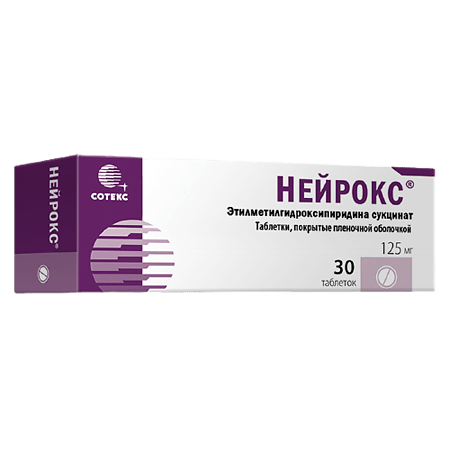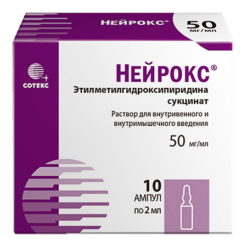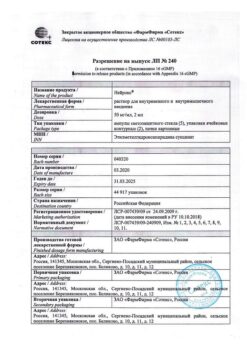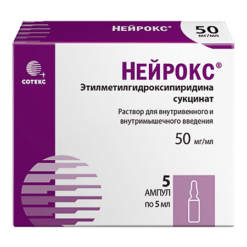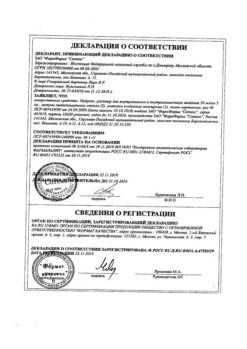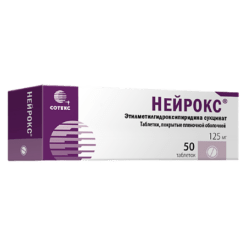No products in the cart.
Neurox, 125 mg 30 pcs.
€6.95 €6.08
Description
Pharmacotherapeutic group: antioxidant drug.
ATX code: N07XX
Pharmacological properties
Pharmacodynamics
Ethylmethylhydroxypyridine succinate is an inhibitor of free radical processes, membranoprotector with antihypoxic, stress-protective, nootropic, anticonvulsant and anxiolytic action. Ethylmethylhydroxypyridine succinate increases the resistance of the body to various damaging factors (shock, hypoxia, ischemia, cerebral circulation disorders, intoxication by alcohol and antipsychotic drugs (neuroleptics)).
The mechanism of action of ethylmethylhydroxypyridine succinate is due to its antioxidant, antihypoxant and membrane-protective action. It inhibits lipid peroxidation, increases superoxide dismutase activity, increases the lipid-protein ratio, reduces membrane viscosity, increases its
fluidity. Ethylmethylhydroxypyridine succinate modulates the activity of membrane-bound enzymes (calcium independent phosphodiesterase, adenylate cyclase, acetylcholinesterase), receptor complexes (benzodiazepine, gamma-aminobutyric acid, acetylcholine), which increases their binding ability to ligands, helps maintain the structural and functional organization of biomembranes, neurotransport and improve synaptic transmission. Ethylmethylhydroxypyridine succinate increases the content of dopamine in the brain. Causes compensatory activation of aerobic glycolysis and a decrease in the degree of inhibition of oxidative processes in the Krebs cycle in hypoxia with an increase in adenosine triphosphate and creatine phosphate, activation of energy-synthesizing functions of mitochondria, stabilization of cell membranes.
It improves metabolism and blood supply to the brain, improves microcirculation and blood rheology, reduces platelet aggregation. Stabilizes membrane structures of blood cells (erythrocytes and platelets) during hemolysis. It has hypolipidemic action, decreases the total cholesterol and low-density lipoproteins.
Antistressor action is manifested in the normalization of post-stress behavior, somatovegetative disorders, restoration of sleep-wake cycles, disturbed learning and memory processes, reduction of degenerative and morphological changes in the various structures of the brain.
Ethylmethylhydroxypyridine succinate has strong antitoxic effect during withdrawal syndrome. It eliminates neurological and neurotoxic symptoms of acute alcohol intoxication, restores behavioral disorders, vegetative functions. It is also able to eliminate cognitive disorders caused by long-term use of ethanol and its withdrawal. Under the influence of ethylmethylhydroxypyridine succinate the effect of tranquilizing, neuroleptic, antidepressant, sleeping pills and anticonvulsants increases, which allows reducing their doses and side effects. Ethylmethylhydroxypyridine succinate improves functional state of ischemic myocardium. In conditions of coronary insufficiency it increases collateral blood supply of ischemic myocardium, promotes preservation of integrity of cardiomyocytes and maintenance of their functional activity. Effectively restores myocardial contractility in reversible cardiac dysfunction.
Pharmacokinetics
Rapidly absorbed when ingested. Maximum concentration at doses of 400-500 mg is 3.5-4.0 mcg/ml. It is rapidly distributed in organs and tissues. Average retention time in the body when administered orally is 4.9-5.2 h. The drug is metabolized in the liver through glucuron conjugation. Five metabolites were identified: 3-oxypyridine phosphate is formed in liver and with the help of alkaline phosphatase is divided into phosphoric acid and 3-oxypyridine; 2nd metabolite – pharmacologically active, is formed in large amounts and is found in urine 1-2 days after injection; 3rd metabolite is excreted in large amounts with urine; 4th and 5th – glucuron conjugates. T1/2 when administered orally is 2.0-2.6 h. It is rapidly excreted with urine mainly as metabolites and in insignificant amount – unchanged. It is excreted most intensively during the first 4 hours after drug administration. Indexes of urinary excretion of unchanged drug and metabolites have individual variability.
Indications
Indications
Consequences of acute cerebrovascular accidents, including after transient ischemic attacks, in the subcompensation phase as preventive courses;
mild traumatic brain injury, consequences of traumatic brain injury;
encephalopathies of various origins (dyscirculatory, dysmetabolic, post-traumatic, mixed);
autonomic dystonia syndrome;
mild cognitive disorders of atherosclerotic origin;
anxiety disorders in neurotic and neurosis-like conditions;
coronary heart disease as part of complex therapy;
relief of withdrawal syndrome in alcoholism with a predominance of neurosis-like and vegetative-vascular disorders, post-withdrawal disorders;
conditions after acute intoxication with antipsychotic drugs;
asthenic conditions, as well as for the prevention of the development of somatic diseases under the influence of extreme factors and stress;
exposure to extreme (stress) factors.
Pharmacological effect
Pharmacological effect
Pharmacotherapeutic group: antioxidant agent.
ATX code: N07XX
Pharmacological properties
Pharmacodynamics
Ethylmethylhydroxypyridine succinate is an inhibitor of free radical processes, a membrane protector with antihypoxic, stress-protective, nootropic, anticonvulsant and anxiolytic effects. Ethylmethylhydroxypyridine succinate increases the body’s resistance to various damaging factors (shock, hypoxia and ischemia, cerebrovascular accidents, intoxication with alcohol and antipsychotics (neuroleptics)).
The mechanism of action of ethylmethylhydroxypyridine succinate is due to its antioxidant, antihypoxic and membrane protective effects. It inhibits lipid peroxidation, increases superoxide dismutase activity, increases the lipid-protein ratio, reduces membrane viscosity, increases it
fluidity. Ethylmethylhydroxypyridine succinate modulates the activity of membrane-bound enzymes (calcium independent phosphodiesterase, adenylate cyclase, acetylcholinesterase), receptor complexes (benzodiazepine, gamma-aminobutyric acid, acetylcholine), which enhances their ability to bind to ligands, helps preserve the structural and functional organization of biomembranes, neurotransmitter transport and improve synaptic transmission. Ethylmethylhydroxypyridine succinate increases dopamine levels in the brain. Causes an increase in compensatory activation of aerobic glycolysis and a decrease in the degree of inhibition of oxidative processes in the Krebs cycle under hypoxic conditions with an increase in the content of adenosine triphosphate and creatine phosphate, activation of the energy-synthesizing functions of mitochondria, stabilization of cell membranes.
Improves metabolism and blood supply to the brain, improves microcirculation and rheological properties of blood, reduces platelet aggregation. Stabilizes the membrane structures of blood cells (erythrocytes and platelets) during hemolysis. Has a lipid-lowering effect, reduces the content of total cholesterol and low-density lipoproteins.
The anti-stress effect is manifested in the normalization of post-stress behavior, somatovegetative disorders, restoration of sleep-wake cycles, impaired learning and memory processes, reduction of dystrophic and morphological changes in various structures of the brain.
Ethylmethylhydroxypyridine succinate has a pronounced antitoxic effect in withdrawal symptoms. Eliminates neurological and neurotoxic manifestations of acute alcohol intoxication, restores behavioral disorders, autonomic functions, and is also able to relieve cognitive impairment caused by long-term use of ethanol and its withdrawal. Under the influence of ethylmethylhydroxypyridine succinate, the effect of tranquilizing, neuroleptic, antidepressant, hypnotics and anticonvulsants is enhanced, which makes it possible to reduce their doses and reduce side effects. Ethylmethylhydroxypyridine succinate improves the functional state of ischemic myocardium. In conditions of coronary insufficiency, it increases collateral blood supply to the ischemic myocardium, helps maintain the integrity of cardiomyocytes and maintain their functional activity. Effectively restores myocardial contractility in reversible cardiac dysfunction.
Pharmacokinetics
Rapidly absorbed when taken orally. The maximum concentration at doses of 400-500 mg is 3.5-4.0 mcg/ml. Quickly distributed in organs and tissues. The average retention time of the drug in the body when taken orally is 4.9-5.2 hours. Metabolized in the liver by glucuron conjugation. 5 metabolites have been identified: 3-hydroxypyridine phosphate – formed in the liver and, with the participation of alkaline phosphatase, breaks down into phosphoric acid and 3-hydroxypyridine; 2nd metabolite – pharmacologically active, formed in large quantities and found in urine 1-2 days after administration; 3rd – excreted in large quantities in the urine; 4th and 5th – glucuron conjugates. T1/2 when taken orally – 2.0-2.6 hours. It is quickly excreted in the urine, mainly in the form of metabolites and in small quantities – unchanged. The most intensive elimination occurs during the first 4 hours after taking the drug. The rates of urinary excretion of unchanged drug and metabolites have individual variability.
Active ingredient
Active ingredient
Ethylmethylhydroxypyridine succinate
Composition
Composition
Active ingredient: ethylmethylhydroxypyridine succinate – 125 mg. Excipients: lactose monohydrate, microcrystalline cellulose 102, potato starch, povidone-K90, croscarmellose sodium, magnesium stearate.
Film shell: Opadry II white 85F48105 (polyvinyl alcohol, macrogol, talc, titanium dioxide).
Pregnancy
Pregnancy
The drug is contraindicated during pregnancy and breastfeeding due to insufficient data on the effectiveness and safety of the drug during these periods.
Contraindications
Contraindications
Acute liver and/or renal failure, increased individual sensitivity to the drug. Due to insufficient knowledge of the action
drug – childhood, pregnancy, breastfeeding. Lactose intolerance, lactase deficiency and glucose-galactose malabsorption syndrome.
Side Effects
Side Effects
Individual adverse reactions may occur: dyspeptic or dyspeptic in nature, allergic reactions.
Interaction
Interaction
Neurox® is combined with all drugs used to treat somatic diseases. Enhances the effect of benzodiazepine drugs, antidepressants, anxiolytics, anticonvulsants and antiparkinsonian drugs. Reduces the toxic effects of ethyl alcohol.
Effect of the drug on the ability to drive vehicles and machinery
During the treatment period, care must be taken when driving vehicles and engaging in other potentially hazardous activities that require increased concentration and speed of psychomotor reactions.
Overdose
Overdose
In case of overdose, drowsiness may develop.
Due to low toxicity, overdose is unlikely. Treatment, as a rule, is not required – the symptoms disappear on their own within 24 hours. In case of severe manifestations, supportive and symptomatic treatment is carried out.
Storage conditions
Storage conditions
In a place protected from light at a temperature not exceeding 25 °C. Keep out of the reach of children.
Shelf life
Shelf life
2 years. Do not use after expiration date.
Manufacturer
Manufacturer
Rapharma JSC, Russia
Additional information
| Shelf life | 2 years. Do not use after the expiration date. |
|---|---|
| Conditions of storage | Store in a light-protected place at a temperature not exceeding 25 °C. Keep out of reach of children. |
| Manufacturer | Rapharma AO, Russia |
| Medication form | pills |
| Brand | Rapharma AO |
Other forms…
Related products
Buy Neurox, 125 mg 30 pcs. with delivery to USA, UK, Europe and over 120 other countries.

